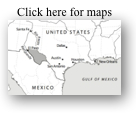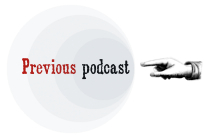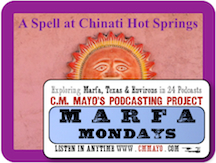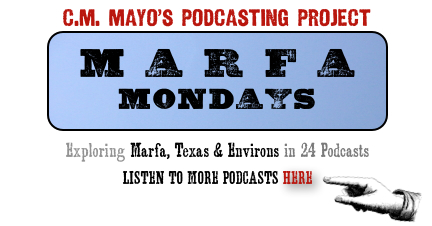|
 [MUSIC] [MUSIC]
Announcer: Welcome to Marfa Mondays with your host, award-winning
travel writer and novelist, C.M. Mayo.
[MUSIC]
C. M. Mayo: Welcome. I'm your host, C.M. Mayo, and this is number
eight in the 24 podcast series "Marfa
Mondays: Exploring Marfa, Texas & Environs" which
began in January 2012 and we'll run on a more or less monthly
basis through December of 2013. [UPDATE: Marfa Mondays has
been expended through 2016.]
This series is a side project of a book I'm writing about, not
just the town of Marfa, but the greater Big Bend region of Far
West Texas. I do know a few things about this book but alas,
not the title. [UPDATE: World
Waiting for a Dream: A Turn in Far West Texas] If you're
listening sometime in the future, my book may have its title
and indeed may have been published, in which case you can find
out all about it, as well as my several other books, at my website,
www.cmmayo.com.
This month's podcast is about a visit to Chinati Hot Springs.
[MUSIC]
One of the most remote
places in the Lower 48, by which I mean, outside of Alaska, there's
no cellphone reception, and no wi-fi for the guests who come
to take the waters. Here's the thing, back in the late '90s,
when I was doing the travelling and other legwork for my book,
Miraculous Air,
I had just started using email, and only because I was working
in a university, and they gave me the account. Spam wasn't the
plague that it is today. I still received bunches of actual letters,
you know, the kind with stamps on them, typed or handwritten,
and it always seemed to me that one to two, on the outside, three
weeks was a reasonable amount of time to take for an answer.
None of the writers I knew had these daunting things called "websites."
Travelling in Baja
California, I didn't carry my cellphone. I didn't have a
cellphone. I didn't bring my laptop; though it was a new one,
it was heavier than a brick, and wi-fi? The Internet then was
all dial-up, treacly slow, and in most places, when travelling
you had to cram yourself into these sweaty little Internet cafes.
Many towns in Baja California, then didn't even have telephones,
never mind Internet service.
It's such a different
world now. Like many people, and including people in small towns
in Baja California, I check my email a few times, sometimes more
than a few times, every day, and it seems a lot of people get
offended, or think I died or something if I take more than 24
hours to answer. Niagaras of emails splash in; oftentimes, and
not because I planned it this way, I'm online several hours a
day. I not only maintain a website, but I blog, I have a YouTube channel,
and I do these
podcasts. I'm not a big participant, but I do have a Facebook
page, and a Twitter feed @MarfaMondays.
As for travelling, nowadays of course, any hotel or restaurant
maintains a website, and you can find almost all of them on sites
like yelp.com, and tripadvisor.com,
where anyone or his cousin's monkey can assign so many stars—or
not. You can Google just about anyone, and anything, it seems,
and get a result.
How did we get so tethered
to all these machines? The idea of travelling in a remote area
incommunicado—why does it now seem so utterly
liberating?
And I live in Mexico City, a vibrant but noisy, traffic-clogged
city. Back in May, in my office with its view of a distant cellphone
tower, I typed in www.chinatihotsprings.net
and gazed longingly at the outdoor soaking tub, cooling shade
trees, the desert in bloom, the cold-water pool, the freshly
painted canary-yellow and turquoise community kitchen with its
chic-looking poured concrete counters, the El Presidente cabin…
"Your oasis," the website said, "in the Chihuhuan
Desert."
Back in May, my aim
was to continue exploring the probable route of Álvar
Núñez Cabeza de Vaca, the conquistador who got
lost in the early 16th century and became the first European
to set eyes on this wondrous country called La Junta, from La
Junta de los Ríos, where the two rivers, the Río
Grande and the Conchos, come together.
And I was interested
in the dramatic geology, the rock art, the natural history, and
the tumult all along that stretch of the river and up into the
canyons on both sides of the US-Mexico border during the Mexican
Revolution at the beginning of the 20th century. Why not take
a couple of days at nearby Chinati Hot Springs?
My journey began in Marfa.
For those of you listening in for the first time and unfamiliar
with the town, Marfa sits plunk in the middle of far west Texas,
about three and a half hours east of El Paso, and west of Austin...
that's a drive longer than you want to think about.
From Marfa, I thought I might get to Chinati Hot Springs by way
of Pinto Canyon Road, a journey of some 50 famously scenic miles
to the southwest, but there had been heavy rains and the road
washed out in several places. So it wasn't even fit for a four-wheel
drive, high-clearance vehicle.
The other option, roundabout from Marfa, was to take 67 South
to Presidio at the US-Mexico border with Ojinaga, then hang a
right and follow the River Road, Farm to Market 170, along the
Rio Grande to Ruidosa, then a right for another seven miles up
at Gravel Road to the Hot Springs. So that, on one hot winter's
day, is what I did.
[SOUND OF TIRES ON
GRAVEL]
Imagine the ocotillos,
those wire-like bouquets in bloom, the Sierra Grande to your
back, the massive Chinatis ahead; the blue, this impossible periwinkle,
and not a single other car.
I'm always mentioning Cenizo Journal in these podcasts.
It's a free magazine distributed in libraries, bookstores, hotels,
and many other places throughout the Big Bend region, but you
can also go to their website, cenizojournal.com, and
download the issues.
It so happened that when I visited Chinati Hot Springs in May,
the second quarter's 2012 issue included an article by David
Keller, "Taming the Healing Waters: The History of the Chinati
Hot Springs," in which he details the visits by the Spaniards
in the late 17th century, and a scattering of settlers in the
19th century. Then there was a Mr. Lee, a miner in the Klondike
Gold Rush, crippled by arthritis, who came to live at the springs
for many years.
The Kingston family had it for a time, then in the 1940s a local
rancher named Edith Rogers leased it as Ruidosa Hot Springs.
In 1967, a Kingston family member took it over again as Kingston
Hot Springs.
Donald Judd, the artist who transformed Marfa, purchasing buildings
and ranches throughout the area, bought the hot springs in 1990.
As Keller puts it, "Judd's intensely private nature and
notoriously rigid aesthetic didn't always resonate with the locals."
Judd closed the hot springs to the public, one member of which
was so disturbed by this, that when the springs came on the market
again after Judd's death, the moment he heard it was for sale,
he offered full price. This was Richard Fenker. The next and
current owner is Ex-Tyco CEO Jeff Fort.
When I arrived at the cluster of sun-drenched cabins alongside
an arroyo filled with cottonwood trees, two Belgians were soaking
in the shade of the communal hot tub. But when I had unfinished
packing, they'd left.
Though there were six cabins, in addition to mine, and a large
area for campers, I didn't see any other guests for the next
24 hours.
There were the two caretakers, Dan and Diana, and a Spanish-speaking
yardman, cutting the grass, raking. Birds of all kinds alit in
the trees, cooing, chirping, whistling.
I had the El Presidente cabin, dedicated to Elvis, decorated
with posters from his movies, "Harum Scarum: 1,001 swingin'
nights, as Elvis brings the big beat to Baghdad." A
black velvet painting of Elvis in his super high collared Las
Vegas phase, and a little library on the desk: Elvis in the
Twilight of Memory; Graceland; and Priscilla's memoir,
Elvis and Me.
Just to say, the decor really wouldn't have worked without that
black velvet painting.
The bathroom had been painted a melony yellow, the tub sunk luxuriously
deep below the floor level, and was made of cement. Water thundered
out of the tap at the perfect temperature for soaking. As the
water slowly cooled, I followed Priscilla's romance in Germany,
in Memphis...
There's no restaurant or snack shop; you bring your own food,
and cook what you will in the communal kitchen. Make coffee,
go sit on the swing overlooking the arroyo for a spell. Go soak
some more.
I kept feeling an inner nudge. Email, I should check my email.
In mid-afternoon, I walked down the arroyo through low canyons
of limestone, watching out for Nelson, the famously cantankerous
wild burro, who never did appear. It was not an easy hike because
of the stones— all sizes, shapes, and many
colors—and the puddles, and mud, and
braids of water still flowing after the past weeks' rains. In
a leisurely, zigzag-y half an hour, I arrived at the Private
Art Gallery, which, I later found out had been made by local
artist Kathleen Griffin. Set in a shallow cave, and into nooks
and crannies along the cake layer-like limestone ledge, I found
painted stones, most small enough to pick up with one hand…faces,
a sun, a lion, a frog, a centipede. Two oval stones were mice,
and a triangular stone painted yellow, their cheese. A whimsical
javelina's profile.
No email, no phone, no television, no other guests... How did
my life, a typical urban life in many ways, encrust itself with
so much noise and clutter? Would had seemed fantastic-no email,
no news, no Internet surfing-now felt like having unloaded a
backpack full of stones, and standing straight, and breathing
deep, stretching out for the first time in an age.
But as I later learned, important people take satellite phones
into such places. On this planet now, our hyper connectivity,
it seems, is inescapable, unless we ourselves, with sheer will,
throw up our own barriers and respect them.
How long until this arroyo has hikers tweeting as they go? Updating
their Facebook pages with each cactus, each sighting of a hawk,
a rabbit, Nelson the wild burro, the little painted stones? I
can see the little painted mice, and their cheese on Facebook,
and 37 people clicking "Like." But who knows? Maybe
by the time we get cellphone reception in the Arroyo, Facebook
will be an antique. Grandpa can tell you about it.
We're losing the magic of being human on this earth, the wonder
of something so simple, as being able to sit on a stone, embraced
by a canyon, sheltered by sky, and just listen to the wind, the
birds, the music of the flies. Watch a lizard dart. A butterfly
tumble. And on that ground, instead of thinking, Who's the jerk
who didn't pick up after their dog? one wonders, What animal's
scat is that, a mule deer, a coyote?
With water to drink, a place to get to before night falls, what's
the hurry? We need other people, but a balance: just as we breathe
out and in, we also need to be alone.
What I took from this experience, brief as it was, was a determination
to come back out of my head and my thousand and ten things to
do, and send and fix and answer and ask, into the world.
Don't laugh... I decided that would be easier if, first, I could
catch up on my email.
Alone in the communal
kitchen, I watched the shadows lengthen. Just outside the window,
cows, six brown, and one pale, came and munched at the grass.
But they were not tame. When I opened the screen door, they fled,
their hooves clattering down the stones on the hillside.
A cricket filled night seeped up from the arroyo, covering the
hills with its purple coolness. It began to seem strange to me
that I would even want to check my email.
In a beam of my flashlight, tiny moths fluttered.
Back in my melon-yellow bathroom, I had another soak with Priscilla
and Elvis, and their long, sad, and unwinding story in Las Vegas.
I slept facing the black velvet Elvis, who was crooning silently
into his black velvet microphone.
[MUSIC; SOUNDS OF BUBBLES]
When I checked out
the next bright and bird filled morning, I asked Diana Burbach,
one of the caretakers, a few questions about the water.
[MUSIC]
Diana Burbach: Here's the water reports.
C.M.
Mayo: So
the water's mostly lithium, right?
Diana Burbach: Yes.
C.M.
Mayo:
And that's really different from the other hot springs in the
area, right? Which are mostly sulfur.
Diana Burbach: Right.
C.M.
Mayo:
The only other hot spring I've been to is Saratoga Springs, which
smelled like rotten eggs.
Diana Burbach: Same way in Mexico, that one
over there across the border.
C.
M. Mayo:
In Ojos Calientes—
Diana Burbach: Yeah! Right over there. We
rode horses over there, and we actually heated up our burritos
on the rocks, because the rocks were just mushy from how hot
in was underneath.
C.M.
Mayo:
Really?
Diana Burbach: But the smell…
C.M.
Mayo:
It was like rotten eggs.
Diana Burbach: Yeah. It was.
C.M.
Mayo:
But here there's no smell, the water is sweet.
Diana Burbach: There's no sulfur.
C.M.
Mayo:
Okay, so I'm looking at the report, and it says- I'm not sure
I understand this— it says tritium,
and "apparent radiocarbon age"?
Diana Burbach: Yeah. That's how they determine
how old it was, and it's actually... I think this is the other
one that they got down there.
C.M.
Mayo:
Okay. So this has...
Diana Burbach: Yeah. This one here, that
was going to be the age. It's going to be over 21 thousand.
C.M.
Mayo:
Over 21 thousand years old?
Diana Burbach: Years old. Yeah.
C.M.
Mayo:
Okay, so when I get in that bathtub, it's water that's 21 thousand
years old.
Diana Burbach: Yeah.
C.M.
Mayo:
Oh my god.
Diana Burbach: It's an old groundwater. It's
part of a deep flow system unaffected by modern recharge.
C.M.
Mayo:
So that's from the last Ice Age?
Diana Burbach: Yes.
C.M.
Mayo:
And how far down is it coming from?
Diana Burbach: Five miles. We had it tested,
and yeah, it is actually the oldest. I think, too, that's why
there's no sulfur.
C.M.
Mayo:
Yeah. I'm looking at the list here and it's got dissolved aluminum,
antimony, arsenic, a tiny bit... barium, beryllium, boron, burmite,
cadmium, chromium, cobalt, copper, iron, lead. Okay, lithium—it's got 138, I'm not sure
what that means.
Diana Burbach: I think it's parts.
C.M.
Mayo:
Parts of lithium. So it's got a fair amount of lithium in it...
manganese, molybdenum, nickel, nitrate, selenium, strontium,
thallium, vanadium, and zinc. I mean, you've just got really,
a mineral bath in there.
Diana Burbach: We did, and I think 'cause
of that lithium. That's why I'm just, it just totally relaxes
you so much. I drink it all day, it's just—
C.M.
Mayo:
It is relaxing.
Diana Burbach: It is, and like I tell people
too, if they're out their drinking in that community hot tub,
it's going to double it. Aand lot of people don't get up the
next morning, like at 10 or 10:30, and they're going, "what
time is it?" I'll tell them, they go, "I never
slept that late!" You know? It is, it does, it just
totally, totally just relaxes you.
C.M.
Mayo:
And it's coming out at about...
Diana Burbach: Eight gallons a minute.
C.M.
Mayo:
So it's basically enough for what you've got here, which is...
Diana Burbach: Yeah. Seven cabins.
C.M.
Mayo:
Seven cabins and an area for the campers. Well, I thank you very
much.
Diana Burbach: Well, thank you.
[MUSIC]
C.M. Mayo:
Thanks so much for listening. I invite you to visit my website,
www.cmmayo.com and click on
"Podcasts" or just go to cmmayo.com/marfa.
Or you can listen in anytime to all the previous podcasts, which
include: an interview with Charles
Angell in the Big Bend; Mary
Bones on the Lost Art Colony; Avram
Dumitriescu, an Artist in Alpine; an interview with Cynthia
McAlister with the Buzz on the Bees: Pollinators in the Chihuhuan
Desert; an interview with Paul
Graybeal, rock hound and owner of Marfa's Moonlight Gemstones;
and the last podcast, which is "We
Have Seen the Lights," about the Marfa Ghost Lights.
There will be a total of 24 podcasts, a few that are in the oven
include, an interview with Adobe visionary Simone Swan, about
her sublime Swan House; an interview with Mary Baxter painting
the landscape; an interview with scholar Enrique Madrid of Redford;
and a drive up the incomparable and very little travelled Pinto
Canyon Road, among other podcasts.
Check back to the website anytime, and for updates, you can simply
click to subscribe
to the RSS feed. If RSS feed is a little too technical for
you, no worries, click on "Join
Mailing List." [Newsletter] I will be very happy to
send you my free newsletter, which always includes the links
to listen in to all the new podcasts.
One last note, on January 29, 2013, I'll be reading from the
manuscript of the book for PEN San Miguel in San Miguel de Allende,
Mexico, and you could read more about that also on the webpage
cmmayo.com, click on "Events."
[UPDATE: Listen
in to the PEN San Miguel Lecture, "A Visit to Swan House"]
[MUSIC]
Announcer: Tune in for Marfa Mondays,
with your host C.M. Mayo, at cmmayo.com/podcasts.
[MUSIC] |






